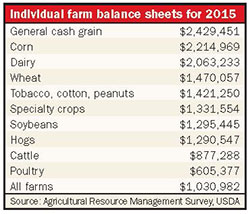There is good reason that state leaders place so much energy recruiting dairy farms to their region. That’s because our businesses represent significant economic engines that generate jobs and commerce throughout rural communities. USDA’s latest Agricultural Resource Management Survey documents dairy’s distinct value.
When it comes to total farm equity, few commodities come close to dairy’s impact. For starters, only general cash grain and corn farms rank higher than dairy among the commodity groups as shown in the table. But even the grain farms don’t carry the economic punch brought by dairy.
Dairy farmers, more so than any other group, have their net worth spread across a wider variety of the 13 asset and liability categories studied by USDA. That generally means money turns over more frequently because those of us who milk cows buy more goods and services than other farmers. That in turn supports more businesses.

On top of all this, dairy product manufacturing employment is nearly recession proof based on the Quarterly Census of Employment and Wages Program. The same cannot be said of other manufacturing sectors that shuttered jobs during the Great Recession.
Dairy does indeed generate significant economic activity and jobs. We should remind others of this fact whenever possible. And when it comes to other animal agriculture sectors, dairy’s average assets are 40 percent larger than hogs and more than double typical cattle and poultry enterprises. Now that represents economic activity.








